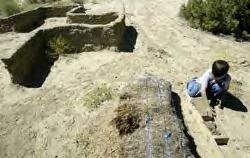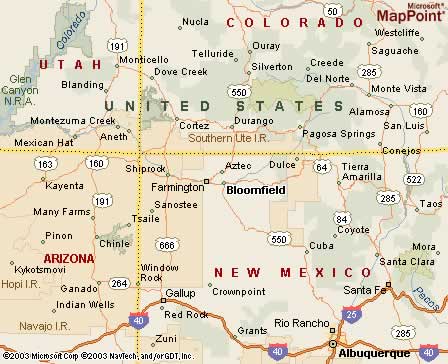|
|
Canku Ota |
|
|
(Many Paths) |
||
|
An Online Newsletter Celebrating Native America |
||
|
September 20, 2003 - Issue 96 |
||
|
|
||
|
Local Children Get Down and Dirty |
||
|
by Carol Cohea/The
Farmington Daily Times
|
||
|
credits: photo
1: Michael Gilliam, 9, pats down a wet adobe brick at Naabi Ani
Elementary School Friday. Students at the school have been building
up adobe walls, left, for ten years as part of early New Mexico
history lessons. photo 2: Seth Booker, 9, (left) and Aaron Stock,
9, carry a bucket of sand back to fellow students while making adobe
bricks at Naabi Ani Elementary in Bloomfield Friday. (all photos
by Ben Chrisman/The Daily Times)
|
|
For the past 11 years the earth science/materials science unit which includes math, social studies, language arts and art has been eagerly anticipated by the annual group of fourth and fifth graders in the school's gifted program. The hands-on, minds-on unit is called Adobe Rock ‘N Roll. It combines the ancient art of making adobe with the modern world of materials science. Materials science is the study of solid matter, both organic and inorganic. Last spring the unit received more exposure when it was published in workbook form by Wards, a leading supplier of science education materials, so kids throughout the U.S., can now experience adobe making. "The kids who did this the first time are now 21," said teacher Chris Carter. She continues to tweak and refine the activities. Over the years, too, the milk cartons used to mold the adobe bricks were changed to shoe boxes and are now wooden forms, thanks to teachers Bill Albee and Dale Latta. Carter, along with Bloomfield teachers Kathy Price and Albee developed the initial idea for the elementary grade classroom when they took a seminar at Los Alamos Laboratories. "We had to come up with an original idea to teach earth science. We came up with this and implemented it in our classrooms," she said. "Anytime you can get a child excited about learning, I feel you have effective teaching, because they don't just look at it or read about it, they do it. And it's fun to play in the mud," Carter said. Vocabulary, social studies, Spanish language, New Mexico history, architecture, and soil information and study are also included in the unit.
They developed their own recipes after discussing and recording in their journals the properties a brick would need to withstand erosion from wind and rain. Some had used fly ash as an ingredient, others straw and some a more traditional blend of sand, silt and clay. Mini bricks were tested for hardness by scratching with a nail, by a drop test and by weight-bearing capabilities. For the weight- bearing capabilities, pupils put the brick on a piece of paper on the floor and then stood on it to see if it would break. "Ours didn't do so well on the drop test, because it busted. But that was only after it was dropped several times," said Clay Payne, 9. Payne was certain the brick with the cup of fly ash was the best. "It held all of our group three people, all five of us at different times, and our teacher!" he explained. Cheryl Pinto, 10, took a break from the durability test to explain what she had learned. "That the Anasazi used adobe to make their houses and pueblos and used it for kivas. The dirt we used was mountain with clay. The dirt from the mountains seems weaker. It's not as strong," she said. "We used straw and dirt," said Elizabeth Foutz, 8, as her group did the durability test. "I think the Indians were very smart to use this building material, because it's one of the most useful resources we have. We have so much dirt. Adobe can do so much," she said. Earlier pupils had learned about the history of adobe buildings around the world from the Middle East to Peru. Also that more than half the world's populations today live in shelters made of earth. "I'm learning about working with numbers and how people lived a long time ago. We're doing a lot of learning. I'm learning a lot from this," said Victoria Burke, 9. Amber Adams, 9, was getting indications during the group discussion that the traditional recipe was the best, "because it can go through anything...erosion, scratching and dropping." "Ours has the best test results," agreed Kylie Greider, 9. On Wednesday, each group thought they had the best bricks. Through discussion and review of data, by Friday the pupils were using the traditional recipe to make authentic adobe bricks and to do repair work on a length of adobe wall that has been a part of their outdoor laboratory for close to 11 years. The interest from Wards, a company which since 1862 has been the leading supplier of science education materials for middle schools and high schools, occurred about four years ago. Former Farmington teacher Carla Ludwig, now of Yellowknife, Canada, was on a plane sitting next to a representative from Wards. One conversation led to another and the rest is history. "It started out for fourth and fifth graders, but the publishers were interested in gearing it up from the fourth grade to middle school science," said Kathy Price, the school district's math specialist. "Carla added the advanced activities for sixth through ninth graders. The workbook has cultural information and it's good science with hands-on activities that kids can learn from. Everybody has dirt around here," Price said. The unit meets National Science Education content standards and benchmarks. The kit can be ordered online from www.wardsci.com. Current teachers for the gifted program of fourth and fifth graders are Carter, Glenace Stanley and Sammi Murray. |
|
|
www.expedia.com |
|
|
||
|
|
||
| Canku Ota is a free Newsletter celebrating Native America, its traditions and accomplishments . We do not provide subscriber or visitor names to anyone. Some articles presented in Canku Ota may contain copyright material. We have received appropriate permissions for republishing any articles. Material appearing here is distributed without profit or monetary gain to those who have expressed an interest. This is in accordance with Title 17 U.S.C. Section 107. | ||
|
Canku Ota is a copyright © 2000, 2001, 2002, 2003 of Vicki Lockard and Paul Barry. |
||
 |
 |
|
|
The "Canku Ota - A Newsletter Celebrating Native America" web site and its design is the |
||
|
Copyright © 1999, 2000, 2001, 2002, 2003 of Paul C. Barry. |
||
|
All Rights Reserved. |
||
 BLOOMFIELD
— Kids, water and mud just seem to naturally attract each
other and that explains the success each year of the adobe brick
building activity at Naaba Ani Elementary.
BLOOMFIELD
— Kids, water and mud just seem to naturally attract each
other and that explains the success each year of the adobe brick
building activity at Naaba Ani Elementary.  Last
week a group of fourth graders were working with their experimental
one-inch by one-inch mini adobe bricks, after studying the properties
of dirt and soil from their own backyards, the mountains and from
around the U.S.
Last
week a group of fourth graders were working with their experimental
one-inch by one-inch mini adobe bricks, after studying the properties
of dirt and soil from their own backyards, the mountains and from
around the U.S.